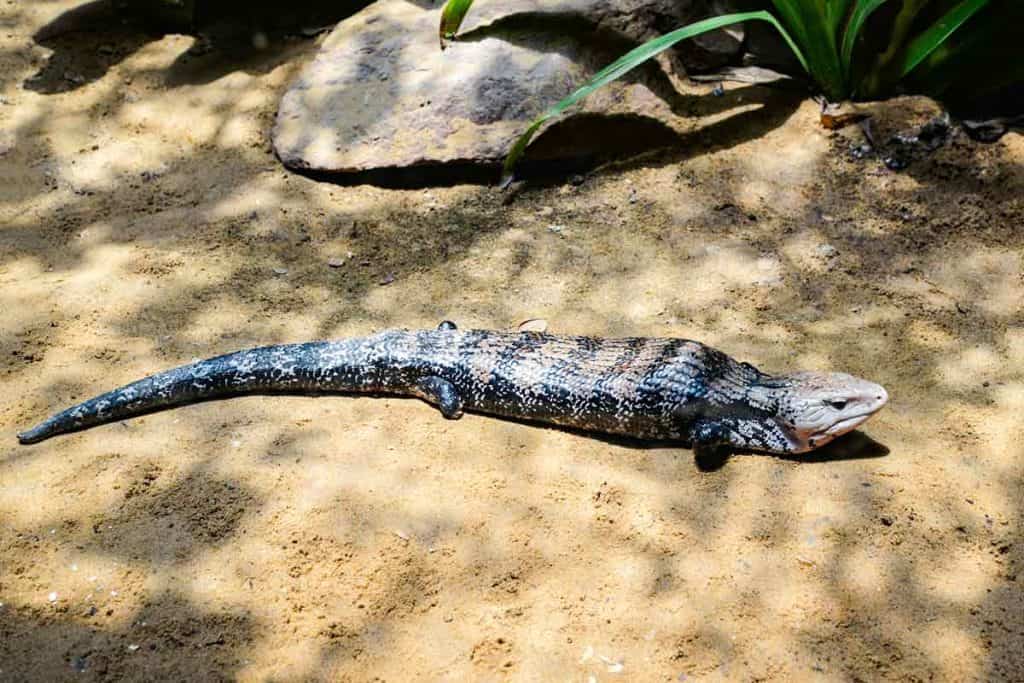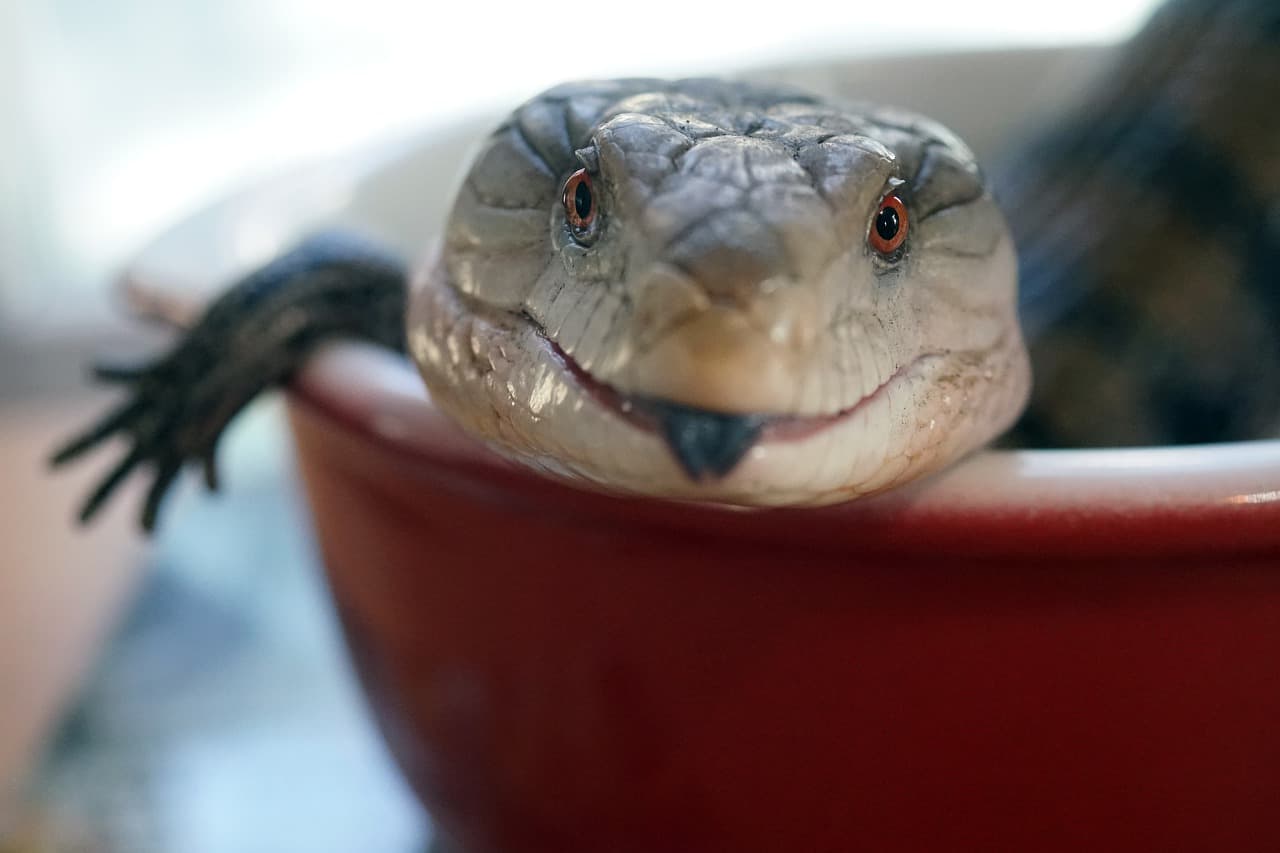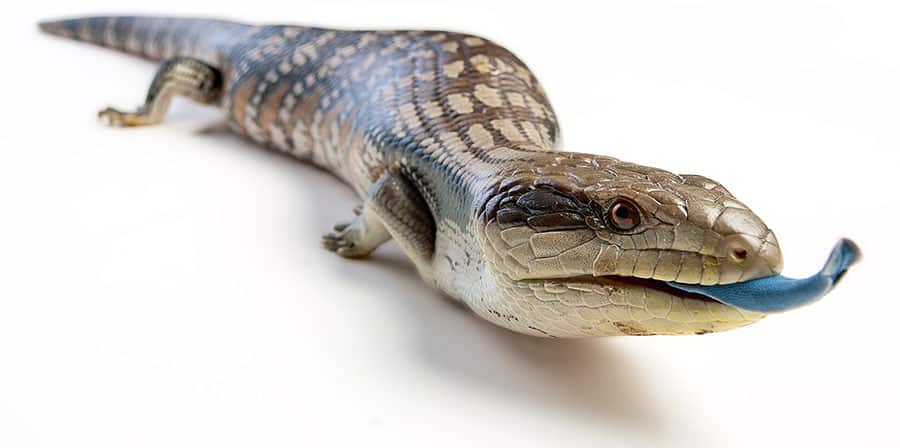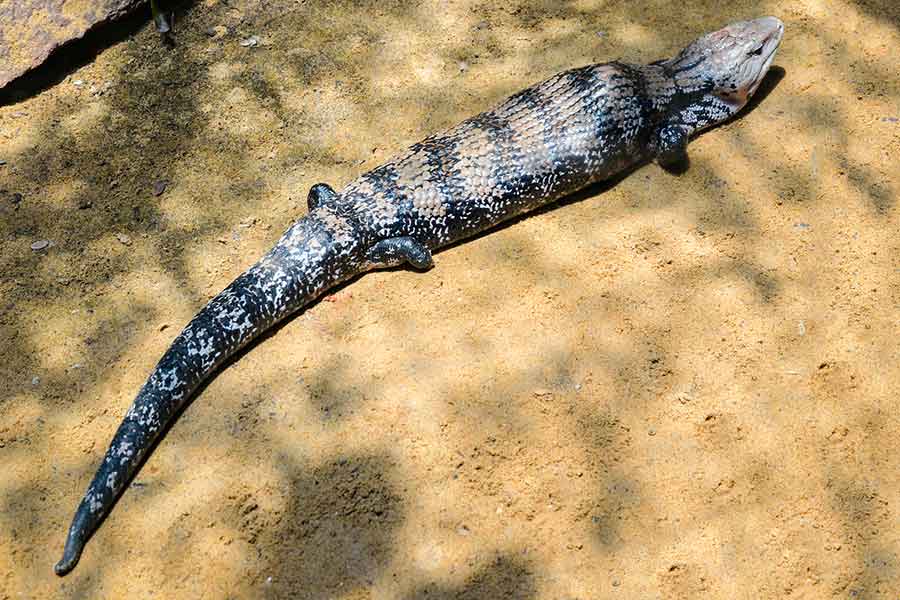Blue-tongued skinks are quite underrated pets in the world of reptile pets! Blue-tongued skink care is actually fairly simple to set up and manage, even for beginner reptile owners. The care of these lizards is comparable to, if not easier than, that of bearded dragons.
These unique lizards need a substantial amount of floor space in their enclosures to move around and be enriched. However, their enclosures do not need to be very tall, as they are completely terrestrial! This means they can still be great pets even if your space is fairly limited.
As far as lizards that are handleable go, blue tongues are some of the best. In general, they are not skittish or aggressive. Their large, hardy bodies also make them easier to handle and less likely to be hurt. This makes them excellent lizards for first-timers as well as older children!
Watching your blue-tongued skink navigate life is an absolute joy. They are active, diurnal creatures and are very inquisitive. Blue tongues are omnivores, which means they have a varied diet, which makes feeding them fun and interesting.
Blue-Tongued Skink Species Overview
There are two main subspecies of blue-tongued skinks that are commonly available as pets: the northern blue-tongued skink (Tiliqua scincoides intermedia) and the Indonesian blue-tongued skink (Tiliqua gigas gigas).
Northern blue tongues come from Australia and are therefore not exported as part of Australia’s legislation on exporting their wildlife. This means the ones found in the US are captive-bred, making them somewhat costly to purchase.
On the other hand, Indonesian blue tongues are easier to come by, as they are mostly wild-caught and imported. This makes them more readily available and cheaper to purchase.
While most of the care is the same for these two species, there is a distinct difference in humidity levels. Incorrect humidity levels can be fatal, so be sure to correctly identify which species of skink you have!
There are many subspecies and variations of the Indonesian and Australian blue tongue skinks. This is an extensive list that can help you decipher which species you have so you can adapt their care accordingly.
Physical Characteristics
The two main species of blue tongue skinks have a similar appearance and build. They both have long, thick bodies that are, on average, 15 to 30 inches in length. Both species have short, strong legs with claw-tipped toes that are ideal for digging. Their heads are large and rectangular, meaning they are perfectly suited for chomping down on snail shells.
Indonesian Blue-Tongued Skink
Indonesian blue-tongued skinks are much darker than their northern blue tongue cousins. They have a grayish base color with black legs.
When it comes to their body color, these particular skinks have bands of green to yellow coloration stretching horizontally along their bodies. Horizontally between the bands, they will be a very dark gray or black. Vertically between the bands, there will be some black speckling.
These unique markings help Indonesian blue tongues blend in with the forest floors they inhabit in the wild.
Northern Blue-Tongued Skink
Northern blue tongues have more of a brownish or tan coloration compared to their Indonesian friends. Their base color is typically a light tan. Along their sides, they have dark brown sections that are broken up by light yellow to orange oval-shaped markings.
These skinks’ legs are light in color, as are their bellies. Along their backs, they have light and dark reddish-tan bands. The further down the tail, the larger the lighter areas get.
These markings help northern blue tongues blend in with the sandy desert environments they inhabit in the wild.
Behavior
Although they are closely related, these two species have some key personality differences. Both species are diurnal, which means they are mainly awake and active during the day.
Both species are also semifossorial, which means they love to dig! This is something you need to be aware of and provide for when caring for a blue tongue skink, but we will cover that in more detail later.
Indonesian Blue-Tongued Skink
Most Indonesian blue tongues available for purchase in the United States are wild-caught. This means they can be a little more aggressive than their northern counterparts, but with early and careful socialization, they are generally docile.
Though wild-caught lizards are a bit more unpredictable than captive-bred individuals, they will not attack their owners without distinct warning. If they do not feel like being handled, they will hiss and attempt to run away. If your skink displays these behaviors, leave them alone, and try handling them again later.
Northern Blue-Tongued Skink
Northern blue tongues that are available for purchase in the US are the products of many generations of captive breeding. This means they are very mellow lizards and rarely show any kind of aggression.
However, we all have times when we are feeling a little grouchy, and the same goes for northern blue tongues. For example, if they are shedding, digesting food, a little too hot, hungry, or just not in the mood to be handled, they will exhibit the same behavior as Indonesian skinks by hissing and attempting to run away to safety.
The Basics of Blue Tongue Skink Care
Enclosure
Regardless of what type of skink you have, setting up their new home will always start with choosing the right enclosure size, shape, and build. There are a lot of factors to keep in mind here, from the material of the enclosure to the substrate you’ll use to cover the floor of the tank.
Enclosure Size
Blue tongue skinks are sizable creatures, so they need a fittingly sizable enclosure to live in.
They are also very active lizards that need to move to get enough exercise and enrichment every day. A small enclosure will stifle their development and lead to a shortened lifespan, physical deformities such as shortened muscles, as well as aggressive behavior.
An adult blue tongue should be housed in a 60-gallon (or larger) enclosure. An enclosure that is at least around 4 feet long, 4 feet wide, and 2 feet tall would be ideal. They do not need a lot of height, as they don’t climb much, but they do need a lot of floor space.
If you only have space for a smaller enclosure, then consider a smaller lizard that is just as fun to hold and care for, such as a leopard gecko or bearded dragon.
Enclosure Material
A glass, plexiglass, or clear cast acrylic (also known as Perspex) enclosure is perfect for the Indonesian blue tongue. These are all ideal for maintaining high humidity levels.
Alternatively, for a northern blue tongue, you could also use a wooden enclosure. Northern blue tongues have low humidity requirements, so you won’t have to worry about the wood rotting over time.
For both species, however, the enclosure should not have mesh or wired walls as this lets too much heat escape. Remember, both types of skinks like it hot!
Substrate
Substrate is the material you’ll put at the bottom of the enclosure as flooring. Depending on your skink’s species, certain substrates will work better than others.
Some cheap alternatives to the most common types of substrate include Kraft paper, paper towels, or newspapers. They will need to be changed regularly, and they do not look as nice or natural as typical loose substrates. However, they do cost considerably less than the more naturalistic alternatives and still perform their function well for both Indonesian and northern blue tongue skinks.
Indonesian Blue-Tongued Skink
Indonesian blue tongues require high humidity. Therefore, they need a substrate that can hold this humidity well. Coconut fiber and forest floor bedding, also known as cypress mulch, are both great options.
Adding in a mixture of sphagnum moss, digging soil, and organic soil will also help bulk up the substrate, provide various textures, and help retain moisture.
If you are wanting to spend more time on the enclosure, make it as natural as possible, and create your own little biome, then a bioactive substrate is the way to go. Bioactive substrates support plant life, maintain humidity, and are perfectly suited for housing a “clean-up crew” of isopods and springtails to help break down waste like pees and poops!
Northern Blue-Tongued Skink
Northern blue tongues need a substrate that is comfortable and won’t hold on to moisture, as they don’t need particularly high humidity to thrive. Dry coconut coir can provide a sturdy burrowing material for northern blue tongues. Orchid bark or dry ReptiChips are also a good way to go.
There are bioactive products for animals better suited to desert regions, too! These bioactive substrates help to maintain low humidity percentages while still providing a naturalistic feel and look for your desert-dwelling, digging skink.
Substrate Depth and Digging
As I have mentioned before, blue tongues love to burrow! Their substrate needs to be at least four inches in depth. However, slightly deeper than this, or around six inches of substrate, is even better.
If you cannot manage to provide them with that depth throughout their enclosure, then your skink will need a digging box located in the middle of their thermal gradient. Their digging box should be large enough for them to fit in comfortably and practice their natural digging habits.
Accessories
Filling your blue tongue’s enclosure with accessories and decorations is not just for show! Anything you add to their enclosure needs to be functional and as natural-looking as possible. Provide your blue tongue with enough dense foliage (either real or fake) in the enclosure so they can get from one end to the other without being seen if they wish. This will help reduce stress and make your skink feel more comfortable in their new home.
While blue tongues are mostly terrestrial and do not climb trees, providing them with some logs and rocks they can climb over is a fun way to encourage them to move around.
Your blue tongue will also need a couple of hides in its enclosure. Hides give your skink cozy shelters where they can hide away from the world when they’re stressed. The hides should be large enough for your lizard to fit their entire body in comfortably but snug enough for them to feel secure.
These hides can be made of various materials, such as PVC pipes that are wide enough, logs, caves, or even upturned plastic containers. The most important thing you need to remember about hides is that they need to be completely opaque. If your skink can see through them, it’ll defeat the purpose of having a hide to begin with!
Lighting and Heating for a Blue Tongue Skink
As they are ectothermic, blue tongue skinks rely on their environment to stay warm. Lighting is also important, as skinks require a regular photocycle with a certain amount of light and dark each day. Finally, we’ll also go over UVB lighting (and whether or not it’s necessary for skinks) below.
Heating
Both blue tongue species like it hot! They should have a stable temperature gradient in their enclosure with a warm side and a cool side. This can be achieved through heating or basking bulbs, under-tank heating pads, or ceramic heat emitters; never use heated rocks, as these can burn your skink’s sensitive belly!
The cool end of your skink’s enclosure should never drop below 65°F at night when all lights are turned off.
The rest of the enclosure should sit between 70°F and 90°F. This is standard for both species.
The main difference between heating the two types of skinks’ enclosures comes down to their basking spots:
- Indonesian blue tongues need a basking spot of 100°F to 105°F.
- Northern blue tongues need a basking spot of 110°F to 115°F.
Lighting
There is a huge debate on whether blue tongue skinks need UVB lighting. Many blue tongues live happy lives without it. However, many breeders and expert carers say their blue tongues that have UVB light are healthier and live longer.
For this reason, I would suggest using a UVB light in your blue tongue’s enclosure. After all, they are diurnal creatures that would naturally get sunlight in the wild, so in captivity, you should always try to mimic their natural habitat as closely as possible.
Your blue tongue should get 12 to 14 hours of light and around 10 to 12 hours of darkness. All lights in the enclosure should be turned off during the dark portion of their photocycle.
Humidity
You must have at least one
Indonesian Blue-Tongued Skink
Indonesian blue tongues need high humidity at around 70% to 80%. This can be achieved through manual misting once or twice daily and using a substrate that will hold the humidity well.
Alternatively, you can invest in an automatic misting system that will release mist periodically to keep humidity levels consistently high.
Northern Blue-Tongued Skink
Northern blue tongues need a much drier environment. They need a humidity range of around 40%. During shedding time, provide them with a humid hide to ease their shedding without increasing the overall humidity in the enclosure.
Food
Your skink’s diet is one of the most important parts of their care. Understanding what they should eat and how often they should eat will keep them healthy and happy for years to come.
Blue tongues are omnivorous and need a diet that is balanced with vegetable matter and animal protein. Hatchings should be fed daily, juveniles should be fed every second day, and adults should be fed every third day.
Their diet should have the following proportions:
60% to 70% animal protein : 20% to 30% plant matter : 0% to 10% fruit
All food items should be no larger than the space between your blue tongue’s eyes. If the item is larger, they run the risk of choking or impaction.
Safe animal protein includes:
- Quail eggs
- Canned snails (never from your garden)
- Mice and rat pinkies/fuzzies
- Crickets
- Dubia roaches
- Phoenix worms
- Silkworms
- Hornworms
Safe plant matter includes:
- Dandelions
- Mustard greens
- Collard greens
- Beet tops
- Yellow and orange squash
- Sweet peppers
- Carrots
Safe fruits include:
- Berries (blackberries, raspberries, strawberries, etc.)
- Apples
- Bananas
- Pears
- Melons
Avoid all citrus fruits, avocados, onions, chives, and all spicy vegetables. Always remove all seeds, pips, pits, and stones before feeding. Rinse any vegetables or fruits with clean, fresh water before feeding as well.
Your blue tongue’s food will need to be dusted in
Water
Your blue tongue must have access to a bowl of fresh, clean water at all times to avoid dehydration. The water dish should be stable, non-porous, and heavy enough that it won’t be tipped over. Be sure to clean and refresh it daily.
Handling a Blue-Tongued Skink
Blue-tongued skinks’ small size and hardy build make them excellent candidates for handling. They are docile and easy to secure in your hands. However, they are not like bearded dragons that can hang onto your shirt or your shoulder with long, strong claws and muscular limbs, so make sure you always hold them securely with both hands at all times.
In general, blue tongues are great lizards for handling. If you want to look for other lizards that love a good cuddle, then check out our list of top 10 lizards that welcome your touch.
FAQs on Blue Tongue Skink Care
Can I house my blue-tongued skink male with a female?
Blue-tongued skinks, whether they are Indonesian or Northern, are not social animals. They can get very aggressive towards others of their kind no matter the sex. It is best to house only one skink per enclosure.
It is also very difficult to sex blue tongues because they are not sexually dimorphic. They require a blood test to determine their sex.
Breeding blue tongue skinks is a difficult process and should be left to the experts to avoid complications and physical injury.
Can my blue tongue drop its tail?
Blue-tongued skinks can drop their tails. However, they do not do this regularly or easily, and tail dropping can be stressful for them. Avoid pulling on your blue tongue’s tail or getting it caught in a door, and their tail will stay on just fine!
Wrapping Up on Blue-Tongued Skinks
Now you know how to care for a blue-tongued sink. They are easy pets to take care of and have decently long lifespans, so your skink can be your best bud for anywhere from 15 to 30 years!
Make sure you know which species you have so you can tailor their enclosure to their needs and keep them in good health!
Overall, both main types of blue-tongued skinks are excellent pets for beginner and expert reptile owners alike. If you are looking for other beginner lizards, check out our list of the top 10 lizards for a newbie herper!





